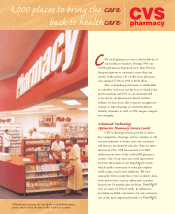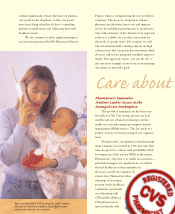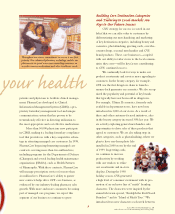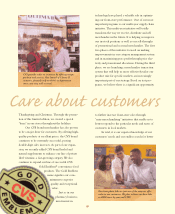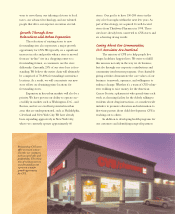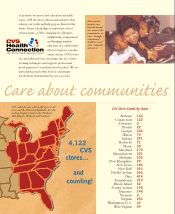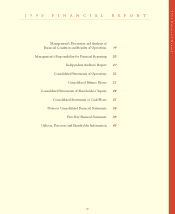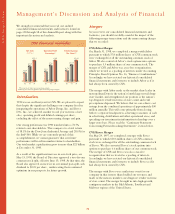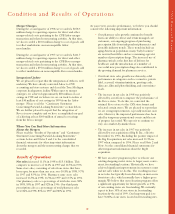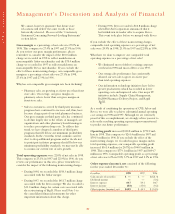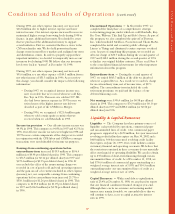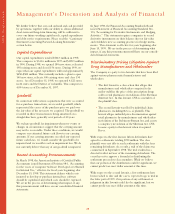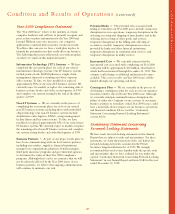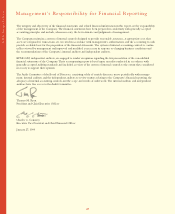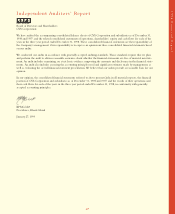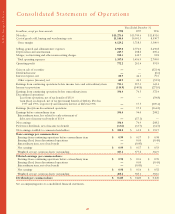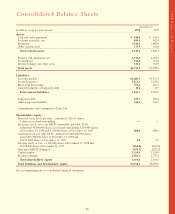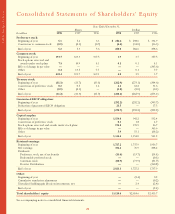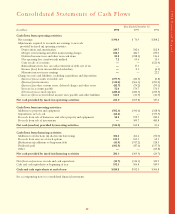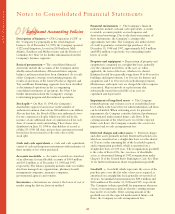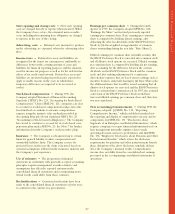CVS 1998 Annual Report Download - page 19
Download and view the complete annual report
Please find page 19 of the 1998 CVS annual report below. You can navigate through the pages in the report by either clicking on the pages listed below, or by using the keyword search tool below to find specific information within the annual report.
17
1998 Financial Report
During 1998, our other expense (income), net increased
$16.8 million due to higher interest expense and lower
interest income. Our interest expense increased because we
maintained higher average borrowing levels during 1998 to
finance, in part, additional inventory. You should be aware
that we purchased the additional inventory to support
several initiatives. First we converted the Revco stores to the
CVS merchandise mix. We also held promotional name
change events in most Revco markets and realigned our stores
and distribution centers. In order to properly support these
important initiatives, we decided to temporarily increase our
inventory levels during 1998. We believe that our inventory
levels were back to “normal” at December 31, 1998.
During 1997, our other expense (income), net increased
$95.6 million to a net other expense of $44.1 million from a
net other income of $51.5 million in 1996. As you review
this change, you should consider the impact of the following
information:
•During 1997, we recognized interest income on a
note receivable that we received when we sold Kay-
Bee Toys in 1996. This note was sold in 1997. We
also had lower interest expense in 1997 because we
retired most of the higher interest rate debt we
absorbed as part of the CVS/Revco Merger.
•During 1996, we recognized a $121.4 million gain
when we sold certain equity securities that we
received when we sold Marshalls in 1995.
Income tax provision ~ Our effective income tax rate was
44.3% in 1998. This compares to 64.8% in 1997 and 42.1% in
1996. Our effective income tax rates were higher in 1998 and
1997 because certain components of the charges we recorded
in conjunction with the CVS/Arbor and CVS/Revco merger
transactions were not deductible for income tax purposes.
Earnings from continuing operations before
extraordinary item increased $319.9 million to $396.4
million (or $0.98 per diluted share) in 1998. This compares
to $76.5 million (or $0.16 per diluted share) in 1997 and
$372.4 million (or $0.95 per diluted share) in 1996. If
you exclude the effect of the nonrecurring charges we
recorded in cost of goods sold and total operating expenses
and the gain on sale of securities included in other expense
(income), net, our comparable earnings from continuing
operations before extraordinary item increased 21.7% to
$510.1 million (or $1.26 per diluted share) in 1998. This
compares to $419.2 million (or $1.05 per diluted share)
in 1997 and $306.8 million (or $0.78 per diluted share)
in 1996.
Discontinued Operations ~ In November 1997, we
completed the final phase of a comprehensive strategic
restructuring program, under which we sold Marshalls, Kay-
Bee Toys, Wilsons, This End Up and Bob’s Stores. As part of
this program, we also completed the spin-off of Footstar,
Inc., which included Meldisco, Footaction and Thom McAn,
completed the initial and secondary public offerings of
Linens ‘n Things and eliminated certain corporate overhead
costs. As part of completing this program, we recorded an
after-tax charge of $20.7 million during the second quarter of
1997 and $148.1 million during the second quarter of 1996
to finalize our original liability estimates. Please read Note 4
to the consolidated financial statements for other important
information about this program.
Extraordinary item ~ During the second quarter of
1997, we retired $865.7 million of the debt we absorbed
when we acquired Revco. As a result, we recorded a charge
for an extraordinary item, net of income taxes, of $17.1
million. The extraordinary item included the early
retirement premiums we paid and the balance of our
deferred financing costs.
Net earnings were $396.4 million (or $0.98 per diluted
share) in 1998. This compares to $76.9 million (or $0.16 per
diluted share) in 1997 and $208.2 million (or $0.52 per
diluted share) in 1996.
Liquidity & Capital Resources
Liquidity ~ The Company has three primary sources of
liquidity: cash provided by operations, commercial paper
and uncommitted lines of credit. Our commercial paper
program is supported by a $670 million, five-year unsecured
revolving credit facility that expires on May 30, 2002 and a
$460 million, 364-day unsecured revolving credit facility
that expires on June 26, 1999. Our credit facilities contain
customary financial and operating covenants. We believe that
the restrictions contained in these covenants do not materially
affect our financial or operating flexibility. We can also obtain
up to $35 million of short-term financing through various
uncommitted lines of credit. As of December 31, 1998, we
had $736.6 million of commercial paper outstanding at a
weighted average interest rate of 5.8% and $34.5 million
outstanding under our uncommitted lines of credit at a
weighted average interest rate of 4.8%.
Capital Resources ~ With a total debt to capitalization
ratio of 25.4% at December 31, 1998, we are pleased to report
that our financial condition remained strong at year-end.
Although there can be no assurance and assuming market
interest rates remain favorable, we currently believe that we
will continue to have access to capital at attractive interest
rates in 1999.
Condition and Results of Operations (continued)


